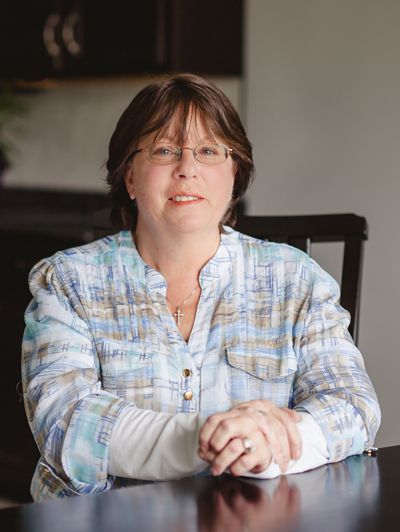Publication
Article
CURE
A New Era of Hope in Lung Cancer
Author(s):
As immunotherapy revolutionizes lung cancer treatment, scientists are considering how to make it work for more of those affected by the disease.
PHOTO COURTESY OF PAM GRIFFITH

PHOTO COURTESY OF PAM GRIFFITH
Pam Griffith’s days were filled with sunshine, golf and trip planning. She and her husband, Randy, were basking in retired life, living on Royal Lakes Golf Course in Lakewood Ranch, Florida. So when a nagging cough would not disappear, she blamed it on seasonal allergies and tried to ignore it. After all, she was too busy to go to the doctor: She played golf three to four days a week with friends and other couples, and she and Randy had just returned from one of their many trips, their first river cruise, down the Rhine River in Germany. “I didn’t want anything to interrupt our lifestyle, so I didn’t make time for that until Ihad to,” says Griffith, age 67. “We don’t stay in the house, and we don’t sit around.”
But after six months of the persistent cough, she mentioned it to her family doctor, who referred her to a pulmonologist. A CT scan revealed a mass in the lower right lobe of her right lung in March 2013. After surgery to remove the lobe and the tumor, she was diagnosed with adenocarcinoma with sarcomatoid cells, a rare combination of non-small cell lung cancer (NSCLC) characteristics that, in the past, have been associated with a relatively poor prognosis because these tumors are resistant to some types of chemotherapy. Griffith began chemotherapy with cisplatin and etoposide, plus radiation, five days a week for seven weeks.
Not only did the treatment cause severe nausea, which led to dehydration, but the cancer began to rapidly spread throughout her body. Visible signs began to pop up: a lesion on the back of her head, a bump on her left shoulder blade, a bulge on the right side of her neck. The chemotherapy wasn’t working, so she and her husband decided to switch from the local oncologist to a large academic cancer center. They turned to Scott J. Antonia, chair of the Thoracic Oncology Department at the H. Lee Moffitt Cancer Center and Research Institute in Tampa, Florida.
In her first visit to Antonia, after a CT scan, he “gave us some news that was absolutely devastating,” Griffith says. “He turned to us and he said, ‘We can no longer hope to cure you.’ And that was shocking. My entire body just went numb. My mind was racing, but I couldn’t move.”
But Antonia did offer the Griffiths a ray of hope: an immunotherapy clinical trial. In September 2013, Griffith enrolled in phase 3 of the CheckMate 057 trial and began to receive the drug Opdivo (nivolumab) every other Wednesday. Just as she had been able to see the cancer bumps growing on her body, she soon was able to watch them shrink. Eventually, there was no sign of cancer. She stayed on Opdivo for almost two years, until August 2015, when she began having joint pain, thought to be a side effect of the drug. She continues to receive a CT scan every three months, but the cancer has stayed away. “The cancer I had was a death sentence,” she says, “but now it’s a whole different ball game, because people are surviving, and the doctors are learning as we all go along.”
A NEW ERA
Immunotherapy is revolutionizing lung cancer treatment, ushering in a new era of hope for those with a disease that is the leading cause of cancer-related death in the United States in both men and women, killing more people every year than breast, prostate and colon cancers combined. It was expected that about 221,000 cases of lung cancer would be diagnosed in 2015, with more than 80 percent of those occurring in patients over age 60.
NSCLC is the most common form of lung cancer, accounting for approximately 85 percent of cases. Small cell accounts for the other 15 percent. There are two main types of NSCLC: squamous cell and the more common nonsquamous cell, which is primarily adenocarcinoma.
Small cell lung cancer, which tends to progress quickly, is usually treated with chemotherapy and radiation, often palliatively, with most patients relapsing in just a few months. In the NSCLC realm, stages 1 and 2 disease can usually be treated first with surgery to remove the tumors, sometimes followed by chemotherapy and/ or radiation. However, because lung cancer often isn’t symptomatic until stages 3 or 4, the majority of people are diagnosed in later stages, when surgery is usually not an option because the cancer has spread throughout the body. In 40 percent of NSCLC cases, the cancer is diagnosed in stage 4; in this stage, fewer than half of patients live a year, and only 10 percent survive two years.
Immunotherapy is typically used only in stage 4 NSCLC, and the most promising type so far has been checkpoint inhibitors. In 2015, one such drug, Opdivo, the therapy that helped Griffith, became the first immunotherapy approved by the U.S. Food and Drug Administration (FDA) for the treatment of lung cancer. Opdivo is approved for metastatic squamous or non-squamous NSCLC and has also been approved to treat the skin cancer melanoma. In NSCLC, the FDA has approved a second checkpoint inhibitor, Keytruda (pembrolizumab), only for patients whose tumors express the protein PD-L1. Both drugs are currently approved only as second-line therapies, to be tried after chemotherapy has stopped working.
Chemotherapy works by attacking any rapidly dividing cells, which include cancer cells. But several types of normal cells in the body that divide can also be affected, leading to chemotherapy side effects including hair loss, diarrhea and drops in blood counts, which in turn can cause increased susceptibility to infection and bleeding. Immunotherapy works differently. It activates the body’s immune system, or T cells, to fight foreign invaders. Side effects are mild for most people and are caused by an immune system working on overdrive. “Cancer puts the brake on the immune system, [and immunotherapy] can release that brake,” says Scott Gettinger, associate professor of medical oncology at Yale Cancer Center and the principal investigator on the Opdivo trials at Yale.
Opdivo and Keytruda are anti-PD-1 drugs. They target one of the cellular “immune checkpoint” pathways known as PD-1/PD-L1, which normally tones down an immune response after a virus or bacteria is dealt with, protecting a person from excessive uncontrolled inflammation. However, some cancers can hijack the PD-1 pathway, engaging PD-1 on immune cells to inactivate them, blunting an anti-tumor immune attack. By blocking PD-1 engagement by cancer, Opdivo and Keytruda allow anti-tumor immune cells to do what they are meant to — attack cancer. In the CheckMate 057 trial, patients on Opdivo lived an average of 12.2 months compared to 9.4 months for patients treated with the chemotherapy drug docetaxel. Additionally, 19 percent of those on Opdivo saw complete or partial tumor shrinkage, compared to 12 percent of those on docetaxel. Furthermore, response to Opdivo lasted substantially longer — the median duration was 17.2 months versus 5.6 months with docetaxel — and with far less severe toxicity (10 percent versus 54 percent). The drug was approved in 2015 for the treatment of patients with advanced squamous NSCLC whose disease has progressed despite platinum-based chemotherapy; later the same year, the approval was expanded to include patients with non-squamous NSCLC.
The FDA granted accelerated approval for Keytruda in October 2015 after it showed effectiveness in a subgroup of 73 patients with tumors that demonstrated high PD-L1 expression. Tumors shrank in 45 percent of patients, with half of the responses lasting at least 12.5 months. The drug is approved to treat patients whose tumors express PD-L1 and have progressed on or after platinum-containing chemotherapy or, in those with EGFR mutations or ALK translocations, after appropriate targeted therapies.
Small inroads of progress are being made in the testing of immunotherapies in small cell lung cancer (SCLC), too. In one 2015 study, patients with PD-L1-positive SCLC tolerated Keytruda well, and the response rate — all partial responses — was 35 percent.
Despite these results, PD-1 blockers work in only about 20 percent of NSCLC patients. They tend to be more effective in patients who demonstrate an over-expression of PD-L1. Paradoxically, some patients whose tumors are not found to express PD-L1 do well on immunotherapy, as well. PD-L1 is not always predictive of results, and oncologists have much more to learn about how it works.
“There’s also a lot of variability in the expression of PD-L1, depending on where the tumor was sampled,” says Rathi Pillai, assistant professor in the Department of Hematology and Medical Oncology at the Winship Cancer Institute at Emory University. “There could be variability between the different sites of disease, whether or not they have expression of PD-L1, and there have been reports that even within a single tumor, depending on the area of the tumor that is biopsied, there could be variability. So it’s not a perfect biomarker that clearly tells us what exactly is going on with the patient’s cancer and their immune system’s response to that cancer.”
However, the success of Opdivo and Keytruda throws open the door for immunotherapy clinical trials, as researchers study the new treatment possibilities from every angle: Does a combination of two immunotherapies work better than one? Does immunotherapy work with certain mutations or specific biomarkers? Does it work better before or simultaneously with chemotherapy, rather than as a second-line option? Is it as effective in never-smokers as it is in smokers? Multiple trials are examining these questions.
Studies are also researching other types of inhibitors of the PD-1/PD-L1 pathway — PD-L1 inhibitors like durvalumab and atezolizumab — and other kinds of checkpoint inhibitors, such as the anti-CTLA-4 drugs tremelimumab and Yervoy (ipilimumab), which has already been approved for the treatment of melanoma. One phase 3 trial that is now recruiting will compare Opdivo with or without Yervoy as a maintenance therapy after treatment for SCLC, pairing up a PD-L1 inhibitor with a CTLA-4 inhibitor. Another phase 3 trial, called Neptune, tests the possibility of using the immunotherapy combination of durvalumab and tremelimumab as a first-line treatment, as compared to standard chemotherapy. And other immunotherapy techniques are being considered too — for instance, vaccines. GV1001, which targets telomerase, an enzyme that extends chromosome length and may allow cells to proliferate continuously, is being tested in patients with inoperable stage 3 NSCLC. And the vaccine TG4010 with first-line chemotherapy is also being considered in a phase 3 trial in patients with advanced NSCLC. In the earlier-phase TIME trial, some subsets of untreated patients with NSCLC tumors that expressed the MUC-1 mutation experienced significantly improved progression-free survival and overall survival when that vaccine was added to standard first-line chemotherapy.
Finally, researchers are testing chimeric antigen receptor (CAR) T cell therapy in lung cancer patients in phase 2 trials. This strategy involves taking T cells from a patient, genetically engineering them in a lab so that they are better equipped to fight lung cancer, and then infusing them back into the patient.
“Many of us believe that PD-1 axis inhibitors will become the backbone of first-line therapy for advanced lung cancer, either alone or in combination with other therapies,” Gettinger says. Even if PD-L1 signaling is not active initially, tumor response to other standard therapies, such as chemotherapy or radiation, can lead to PD-L1 expression (aimed at) protecting the tumor from further attack.”
BEATING THE ODDS
In a small percentage of patients, immunotherapy works remarkably well. Oncologists are trying to determine what makes these cases unique.
PHOTO BY KYLE STEVENSON

PHOTO BY KYLE STEVENSON
Sharon Long has been taking Opdivo since October 2014 and has no plans to go off the drug. She was diagnosed with adenocarcinoma in February 2014 after becoming severely short of breath after a 12-hour shift as a hospital nurse. “I was actually drugged when I was told. That helped quite a bit,” says Long, 55, of New Haven, Indiana, who had been given Ativan (lorazepam) before an emergency procedure to drain the large amount of fluid around her heart; the drug also relaxed her when she was given her cancer diagnosis. “I think it hit harder when I went to the doctor and he said ‘no surgery, no radiation,’ because stage 4 is chemo-only.”
After a combination of carboplatin and pemetrexed chemotherapy failed, Long joined an Opdivo trial, CheckMate 153, and her tumors — too numerous to count — began to shrink. She now has only a small tumor in her right lung, a node on her thyroid and a small tumor on her left adrenal gland, which have all been stable for about a year. “I’m amazed I’ve made it two and a half years,” Long says. “I have a new grandchild, and my first one turned 3. We’ve moved, and I’ve got a house now that I sit back and relax in. I’m in a really happy place.”
Unfortunately, a lot of patients don’t fare as well as Long has.
“A minority of the responders are long-term survivors, and we don’t know why as of yet,” says Chandra Belani, director of translational and clinical investigations at the Penn State Hershey Cancer Institute. “The long-term survival rate will be the best parameter to compare various agents and validate these predictive biomarkers.”
Another problem is that some patients develop a resistance to the drug, but oncologists hope a combination therapy will reduce the risk of resistance by fighting the cancer through different mechanisms simultaneously, says Yanis Boumber, assistant professor in the Department of Internal Medicine, Division of Hematology/Oncology, at the University of New Mexico School of Medicine. In addition, a combination might help increase the effectiveness in patients who are PD-L1 negative, who typically don’t do as well or for as long on the PD-L1 inhibitors as do patients who are PD-L1 positive, he says.
Side effects, too, can interfere with the success of immunotherapy. For most patients, immunotherapy side effects are much less severe than those generated by chemotherapy, potentially including fatigue, thyroid dysfunction, musculoskeletal pain, cough, constipation and loss of appetite. Most of these side effects are mild and can be effectively managed with drugs, Boumber says.
“This drug did not make me sick; I didn’t lose my hair, none of that,” Griffith says. After each treatment, a red rash would appear on the top of her feet but disappear after a few days. But after one year on Opdivo, she began to have inflammation and pain in her joints, and she stopped taking the drug at almost the two-year mark. She sees an arthritis specialist to manage her joint inflammation, a known potential side effect of Opdivo. It’s unknown whether the inflammation will eventually subside.
Other severe side effects, such as inflammation in the lung or colon, can also cause patients to stop taking immunotherapy. Ultimately, scientists hope to bring more patients with lung cancer into the fold among those who can benefit from immunotherapy.
“The idea is (that), if we can convert lung cancer to a chronic condition, we can keep patients on these drugs for a long time and make them live longer,” Boumber says. “This is just the beginning of a new era. There is a prediction that, in 10 years, immunotherapy will be more than 50 percent of all oncology drugs. It’s a revolution in oncology.”
Opdivo and Keytruda are just the tip of the iceberg, Gettinger adds. “The early success with PD-1 checkpoint inhibitors has provided just a glimpse into the potential of the immune system to attack and control cancer. We have entered a new era of cancer care, one in which a patient’s own immune system will be increasingly harnessed to treat cancer, leading to long-term survival with good quality of life.”






